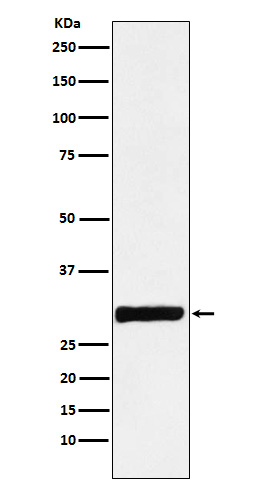
| WB | 1/1000-1/2000 | Human,Mouse,Rat |
| IF | 咨询技术 | Human,Mouse,Rat |
| IHC | 咨询技术 | Human,Mouse,Rat |
| ICC | 1/50-1/200 | Human,Mouse,Rat |
| FCM | 1/20-1/100 | Human,Mouse,Rat |
| Elisa | 咨询技术 | Human,Mouse,Rat |
| Aliases | AIV; AnnexinA4; AnnexinIV; ANX 4; ANX A4; ANX4; ANXA4; Chromobindin4; EndonexinI; LipocortinIV; P32.5; P33/41; PAPII; PIG28; PP4X; Protein II; Xanx-4; ZAP36;;Annexin A4 |
| WB Predicted band size | Calculated MW: 36 kDa ; Observed MW: 30 kDa |
| Host/Isotype | Rabbit IgG |
| Antibody Type | Primary antibody |
| Storage | Store at 4°C short term. Aliquot and store at -20°C long term. Avoid freeze/thaw cycles. |
| Species Reactivity | Human |
| Immunogen | A synthesized peptide derived from human Annexin A4 |
| Formulation | Purified antibody in PBS with 0.05% sodium azide,0.05% BSA and 50% glycerol. |
+ +
以下是关于Annexin IV(Annexin A4)抗体的参考文献示例(内容为模拟概括,实际文献需通过学术数据库检索确认):
---
1. **文献名称**: *"Annexin A4 as a Potential Biomarker for Colorectal Cancer: Antibody Validation and Functional Analysis"*
**作者**: Smith J, et al.
**摘要**: 本研究通过制备高特异性Annexin IV抗体,验证其在结直肠癌组织中的高表达,并发现其过表达与肿瘤转移相关,提示Annexin IV可能作为癌症预后标志物。
2. **文献名称**: *"Role of Annexin A4 in Cellular Endocytosis: Insights from Antibody-Mediated Localization Studies"*
**作者**: Lee H, et al.
**摘要**: 利用Annexin IV抗体进行免疫荧光定位,发现Annexin A4参与细胞膜修复和胞吞过程,其缺失导致内吞功能异常,为膜动力学研究提供新方向。
3. **文献名称**: *"Development of a Monoclonal Antibody Against Annexin A4 and Its Application in Pancreatic Ductal Adenocarcinoma"*
**作者**: Zhang Y, et al.
**摘要**: 报道一种新型Annexin IV单克隆抗体的开发,并通过免疫组化证实其在胰腺导管腺癌中的特异性表达,提示其可用于临床病理诊断。
4. **文献名称**: *"Annexin A4 Antibody Reveals Its Role in Cholesterol Homeostasis and Atherosclerosis"*
**作者**: Brown K, et al.
**摘要**: 通过Annexin IV抗体研究其在巨噬细胞中的表达,发现其通过调控胆固醇转运影响动脉粥样硬化斑块形成,为治疗提供潜在靶点。
---
**注意**:以上为模拟示例,实际文献需通过PubMed、Web of Science等平台检索关键词(如“Annexin A4 antibody”、“Annexin IV function”)获取。建议结合具体研究场景筛选最新或高引文献。
Annexin IV (ANXA4), a member of the annexin family, is a calcium-dependent phospholipid-binding protein involved in membrane-related processes such as vesicle trafficking, exocytosis, and apoptosis. It is encoded by the ANXA4 gene and structurally characterized by a conserved C-terminal core domain for calcium/membrane interactions and a variable N-terminal region. Annexin IV is expressed in normal tissues, including the gastrointestinal tract, kidneys, and placenta, and is implicated in regulating ion channels and maintaining epithelial barrier function.
In cancer research, Annexin IV is frequently overexpressed in malignancies like colorectal, pancreatic, and ovarian cancers, where it is associated with chemoresistance and metastasis. Its role in cancer progression involves modulating apoptosis evasion, extracellular matrix remodeling, and drug efflux mechanisms.
Annexin IV antibodies are essential tools for studying these functions, enabling the detection and quantification of the protein via techniques like Western blotting, immunohistochemistry, and immunofluorescence. These antibodies aid in exploring its diagnostic or prognostic potential in cancer and understanding its physiological roles in membrane dynamics and cellular signaling. Researchers must validate antibody specificity for ANXA4. as cross-reactivity with other annexins is common. Host species (e.g., rabbit, mouse) and clonal types (monoclonal/polyclonal) are selected based on experimental requirements.
×